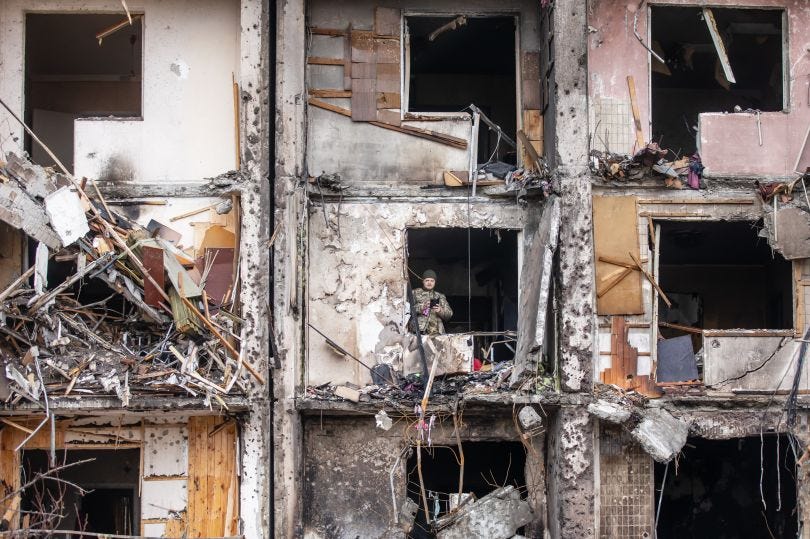Soon you’ll receive the usual Global Eyes—“Global Eyes: Globe”—because as critical as this is, the rest of the world has not stopped spinning on its axis. But for now, the main thing is the main thing, as Tecumseh Court teaches us. —Claire
From the Institute for the Study of War, which is both serious and credible:
March 3, 4:00 pm EST
The Russian military has continued its unsuccessful attempts to encircle Kyiv and capture Kharkiv. The Russians continued to attack piecemeal, committing a few battalion tactical groups at a time rather than concentrating overwhelming force to achieve decisive effects. Russian commanders appear to prefer opening up new lines of advance for regiment-sized operations but have been unable to achieve meaningful synergies between efforts along different axes toward the same objectives. They have also continued conducting operations in southern Ukraine along three diverging axes rather than concentrating on one or attempting mutually supporting efforts. These failures of basic operational art—long a strong suit of the Soviet military and heavily studied at Russian military academies—remain inexplicable as does the Russian military’s failure to gain air superiority or at least to ground the Ukrainian Air Force. The Russian conventional military continues to underperform badly, although it may still wear down and defeat the conventional Ukrainian military by sheer force of numbers and brutality. Initial indications that Russia is mobilizing reinforcements from as far away as the Pacific Ocean are concerning in this respect. Those indications also suggest, however, that the Russian General Staff has concluded that the forces it initially concentrated for the invasion of Ukraine will be insufficient to achieve Moscow’s military objectives.
Operations to envelop Kyiv remain Russia’s main effort. Russian troops are also continuing three supporting efforts, one to seize Kharkiv, one to take Mariupol and secure the “land bridge” connecting Rostov-on-Don to Crimea, and one to secure Kherson and set conditions for a drive west toward Mykolayiv and Odesa.
The Russian attack on Kyiv likely consists of a main effort aimed at enveloping and ultimately encircling the city from the west and a supporting effort along the axes from Chernihiv and Sumy to encircle it from the east.
Russian forces in the south resumed offensive operations toward Mykolayiv on March 3 after securing Kherson on March 2, but do not appear to pose an imminent danger to Odesa. Russian forces likely seek to force Mariupol to capitulate by destroying critical civilian infrastructure and killing civilians to create a humanitarian catastrophe—an approach Russian forces have repeatedly taken in Syria.
Readers of the Cosmopolitan Globalist will spot immediately that the authors are appealing to concepts discussed in the second part of WAR 101.
(Class? Did you catch it?)
If you didn’t notice it, go back and read it again. Here’s Part I and here’s Part II. We’re translating this into Ukrainian right now and sincerely hoping this series will be useful to teenagers—and adults, and grandparents—who’ve just had AK-47s thrust into their arms and been told it’s up to them to defend their country against the most ruthless invader on the planet.
We wrote it in the simplest language we could because we wanted Ukrainians who don’t speak good English to be able to read and profit from it right away. So sophisticated military historians may think the points Tecumsah Court makes are simplistic, or primitive. But as Tecumseh Court stresses, primitive is what war is about; besides, “ground combat will rid you of your fine motor coordination, your peripheral vision, and your ability to think past three.” Tecumseh Court knows what Tecumseh Court is talking about. Tecumseh Court has had, alas, a lot of experience.
We’re also translating it into Ukrainian. If you’d like to support the effort to translate and disseminate it, please subscribe! If you’ve subscribed already, please give a subscription to a friend who would benefit from it.
Russian forces seize huge Ukrainian nuclear plant, fire extinguished. “Fears of a nuclear disaster at the Zaporizhzhia plant spread alarm across world capitals.” While the Cosmopolitan Globalist doesn’t pretend to know what Putin is thinking, we wonder if this was meant to remind Europe that it’s terrified of nuclear power. If so, it was another grave miscalculation: It only succeeded in reminding Europe why it’s terrified of Vladimir Putin. The good news is that the Zaporizhzhia reactors are much more modern and much, much safer than the catastrophic Chernobyl design.
Volodymyr Zelensky survives three assassination attempts in days. “Two different outfits have been sent to kill the Ukrainian president—mercenaries of the Kremlin-backed Wagner group and Chechen special forces. Both have been thwarted by anti-war elements within Russia’s Federal Security Service (FSB).” As Tecumseh Court asked in WAR 101, Part I, what is the succession plan if they succeed next time, and is his designated successor somewhere safely far from Kyiv?

Robert Zubrin writes CLOSE THE SKY for the Kiev Post:
Keep reading with a 7-day free trial
Subscribe to The Cosmopolitan Globalist to keep reading this post and get 7 days of free access to the full post archives.





